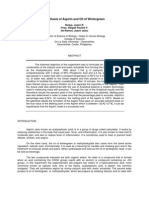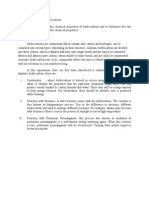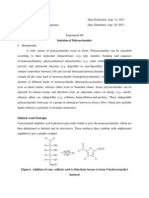CONCLUSION
CONCLUSION
Uploaded by
Xyrelle NavarroCopyright:
Available Formats
CONCLUSION
CONCLUSION
Uploaded by
Xyrelle NavarroCopyright
Available Formats
Share this document
Did you find this document useful?
Is this content inappropriate?
Copyright:
Available Formats
CONCLUSION
CONCLUSION
Uploaded by
Xyrelle NavarroCopyright:
Available Formats
IV.
CONCLUSION
Carbohydrates are aldehyde or ketone compounds with multiple hydroxyl groups. They make up
most of the organic matter on Earth because of their extensive roles in all forms of life. First,
carbohydrates serve as energy stores, fuels, and metabolic intermediates. Second, ribose and
deoxyribose sugars form part of the structural framework of RNA and DNA. Third, polysaccharides are
structural elements in the cell walls of bacteria and plants. In fact, cellulose, the main constituent of
plant cell walls, is one of the most abundant organic compounds in the biosphere. Fourth, carbohydrates
are linked to many proteins and lipids, where they play key roles in mediating interactions among cells
and interactions between cells and other elements in the cellular environment.
However, these six tests can be performed for the qualitative analysis of carbohydrates.
Presence of carbohydrates can be confirmed qualitatively by several tests. Due to the presence of
different numbers of sugar units specific carbohydrates exhibit typical color reactions that form the basis
for their identification. The first test which is the Molisch’s test gives positive reaction for all
carbohydrates and is based on the dehydration of the carbohydrate by Sulphuric acid to produce an
aldehyde, which condenses with two molecules of α-naphthol, resulting in appearance of a purple ring
at the interface. The Bial’s Orcinol test, on the other hand, distinguished between a pentose and hexose
and thus contains orcinol in concentrated HCl with a small amount of FeCl3 catalyst and forms a blue-
green product. The Seliwanoff’s test, on the other hand, is used to distinguish between ketoses
(contains ketone group) and aldoses (contains aldehyde group) and thus ketoses are more rapidly
dehydrated than aldoses when heated and forms a red product. The Benedict’s test, on the other hand,
wherein the copper ions will attract the electrons from the aldehyde or ketone group changing the
charged copper ions to a neutral metal and the Copper ions are blue in color whereas copper metal is
orange and thus blue color indicates no change. The Barfoed’s test, on the other hand, is used to
distinguish between reducing monosaccharides and disaccharides which contains cupric ions in an acidic
solution and thus shows the presence of a monosaccharide resulting in a red precipitate. Lastly, the
Phenylhydrazine, is used to identify and differentiate sugars encountered in clinical practice and can also
be used to identify reducing sugar and if it reacts with the carbonyl group of the sugar, it will result then
in the formation of phenylhydrazone and the osazone.
Therefore, carbohydrates are the main energy source for the human body. Chemically,
carbohydrates are organic molecules in which carbon, hydrogen, and oxygen bond together in the ratio:
Cx(H2O)y, where x and y are whole numbers that differ depending on the specific carbohydrate to which
we are referring. Animals (including humans) break down carbohydrates during the process of
metabolism to release energy. All carbohydrates are made up of units of sugar (also called saccharide
units). Simple sugars are sweet in taste and are broken down quickly in the body to release energy. Two
of the most common monosaccharides are glucose and fructose. Glucose is the primary form of sugar
stored in the human body for energy. Starch is the principal polysaccharide used by plants to store
glucose for later use as energy. Glycogen, another polymer of glucose, is the polysaccharide used by
animals to store energy. Excess glucose is bonded together to form glycogen molecules. Both starch and
glycogen are polymers of glucose; however, starch is a long, straight chain of glucose units, whereas
glycogen is a branched chain of glucose units.
You might also like
- Synthesis of Aspirin and Oil of WintergreenDocument5 pagesSynthesis of Aspirin and Oil of WintergreenJason Raquin Roque100% (4)
- Effect of Heat & PH On Color & Texture of Green VegsDocument5 pagesEffect of Heat & PH On Color & Texture of Green VegsJeanette Utter33% (6)
- Experiment Properties of AlkenesDocument3 pagesExperiment Properties of AlkenesMei Hui100% (8)
- CHM1024 Report 4: Reactions of AlcoholsDocument15 pagesCHM1024 Report 4: Reactions of AlcoholsAkmal Adib Fadzil83% (18)
- CHM1024 Report 5: Reactions of Aldehydes and KetonesDocument14 pagesCHM1024 Report 5: Reactions of Aldehydes and KetonesAkmal Adib Fadzil96% (98)
- Urinalysis Lab Report 2Document7 pagesUrinalysis Lab Report 2salman ahmedNo ratings yet
- Non Enzymatic BrowningDocument10 pagesNon Enzymatic Browninghurm350% (2)
- Experiment LipidsDocument5 pagesExperiment LipidsSHAFIKANOR3661No ratings yet
- Experiment 1: CarbohydratesDocument6 pagesExperiment 1: CarbohydratesEM Alberts100% (3)
- Results and Discussion For CarbohydratesDocument4 pagesResults and Discussion For CarbohydratesDusky25% (4)
- Formal Report, Carboxylic Acid and DerivativesDocument4 pagesFormal Report, Carboxylic Acid and DerivativesVicente Romeo M Macatangay88% (8)
- EXPERIMENT 5 Food Chemistry Egg White AlbuminDocument5 pagesEXPERIMENT 5 Food Chemistry Egg White AlbuminNurmazillazainal100% (3)
- Lab 11Document8 pagesLab 11Algenne AmiruddinNo ratings yet
- Lab Report Bio Exp 1Document3 pagesLab Report Bio Exp 1NurulHaidah100% (4)
- 4 Microbiology Lab Report Practical 3 PDFDocument10 pages4 Microbiology Lab Report Practical 3 PDFNurul IzzahNo ratings yet
- Chem. 14.1 - Expt. 9 Chem Lab Report - Chemical EquilibriumDocument3 pagesChem. 14.1 - Expt. 9 Chem Lab Report - Chemical EquilibriumRomi Necq S. Abuel40% (5)
- Lab 3 Report Plant ANATOMYDocument9 pagesLab 3 Report Plant ANATOMYEizuwanEizuddin50% (2)
- Organic ChemistryDocument4 pagesOrganic ChemistryChan Jiun Haur83% (6)
- Mic125 Laboratory Report Lab 2Document14 pagesMic125 Laboratory Report Lab 2aisyah fauzi100% (2)
- Lab Report Biochemistry-Estimation of Iodine Value of Fats and OilsDocument6 pagesLab Report Biochemistry-Estimation of Iodine Value of Fats and OilsNida Ridzuan67% (3)
- Lab Report 5Document12 pagesLab Report 5aryavijay78% (9)
- Lab # 2Document4 pagesLab # 2Martyn PereiraNo ratings yet
- Benedict'S Test: Procedure Results && Discussion ApplicationsDocument20 pagesBenedict'S Test: Procedure Results && Discussion ApplicationsImmanuel Lashley33% (3)
- Barfoeds TestDocument6 pagesBarfoeds TestcresNo ratings yet
- 12-13 L1 Hydrilla (T)Document3 pages12-13 L1 Hydrilla (T)yanyanyan__100% (1)
- Conclusion & RecommendationDocument2 pagesConclusion & RecommendationnajihahNo ratings yet
- Bial's Orcinol Test Result Substance Tested Color Reaction DescriptionDocument2 pagesBial's Orcinol Test Result Substance Tested Color Reaction DescriptionXyrelle NavarroNo ratings yet
- General and Specific Tests For CarbohydratesDocument13 pagesGeneral and Specific Tests For CarbohydratesKai Chen50% (2)
- Analysis of Saliva SNDocument2 pagesAnalysis of Saliva SNMauralenAbadinesCabaguingNo ratings yet
- Exp 1 Properties of HydrocarbonDocument4 pagesExp 1 Properties of HydrocarbonNigel LoewNo ratings yet
- Experiment 6 Milk AnalysisDocument6 pagesExperiment 6 Milk AnalysisNur Sabrina Rosli100% (3)
- Experiment 1 Qualitative Analysis of CarbohydratesDocument14 pagesExperiment 1 Qualitative Analysis of CarbohydratesEko Nevrian91% (11)
- Eggs Lab ReportDocument18 pagesEggs Lab Reportapi-305617091No ratings yet
- Lab Report 4 sbl1023Document7 pagesLab Report 4 sbl1023api-3850387010% (1)
- CONCLUSION ProteinDocument2 pagesCONCLUSION ProteinFadhlin SakinahNo ratings yet
- Exp 3 Analysis of Meat (Discussion, Conclu and Ref)Document2 pagesExp 3 Analysis of Meat (Discussion, Conclu and Ref)Nur SyahirahNo ratings yet
- Experiment No. 2 CarbohydratesDocument2 pagesExperiment No. 2 CarbohydratesYellow100% (1)
- Conclusion and Recommendations3Document2 pagesConclusion and Recommendations3Lara Melissa Orense100% (7)
- LAb 6Document20 pagesLAb 63amabelle arevalo100% (2)
- Iodine Titrimetry Vit CDocument6 pagesIodine Titrimetry Vit CMuhamad Afidin100% (1)
- Experiment 3Document13 pagesExperiment 3Iqmal Hafidz100% (1)
- Test For Reducing SugarsDocument3 pagesTest For Reducing SugarsFaizal Halim100% (1)
- Protein Lab Report 3Document7 pagesProtein Lab Report 3shuba63% (8)
- Ethanol Emulsion TestDocument3 pagesEthanol Emulsion TestCleo Poulos67% (3)
- Experiment 6Document12 pagesExperiment 6Keo De Leon100% (3)
- Moores Test and Barfoeds TestDocument3 pagesMoores Test and Barfoeds TestFrancis Calo100% (1)
- Formation of Gluten in Different Types of FlourDocument3 pagesFormation of Gluten in Different Types of FlourHamizan FitriNo ratings yet
- Biochem Lab ReportDocument4 pagesBiochem Lab ReportChryza Faith QuicoyNo ratings yet
- Experiment 6 - CarbohydratesDocument4 pagesExperiment 6 - CarbohydratesShaira Dawn PlancoNo ratings yet
- Lab Report Ash DeterminationDocument4 pagesLab Report Ash DeterminationHusna Atiqah100% (1)
- Isolation, Hydrolysis, and Characterization of GlycogenDocument4 pagesIsolation, Hydrolysis, and Characterization of GlycogenRyan Enriquez100% (1)
- Lab Rep 7 Chem - Carboxylic Acids & DerivativesDocument7 pagesLab Rep 7 Chem - Carboxylic Acids & DerivativesSteffi Grace NotaNo ratings yet
- Experiment 5 - GlycogenDocument5 pagesExperiment 5 - GlycogenGrace Aquino67% (6)
- Mayonnaise Lab ReportDocument6 pagesMayonnaise Lab Reportapi-298392554100% (2)
- Blood Grouping ReportDocument6 pagesBlood Grouping ReportPriyo Priyonti57% (7)
- Exp 6 BiochemDocument5 pagesExp 6 BiochemL-yeah TraifalgarNo ratings yet
- Assignment 2 SciDocument2 pagesAssignment 2 Scitrisha sobitoNo ratings yet
- Experiment Biological DiversityDocument9 pagesExperiment Biological DiversityAiman ShukrieNo ratings yet
- Carbohydrates and LipidsDocument8 pagesCarbohydrates and Lipidshibadesi00No ratings yet
- Biology For The IB Diploma Chapter 2 SummaryDocument8 pagesBiology For The IB Diploma Chapter 2 SummaryJulian WolfgangNo ratings yet
- GEntrep Chapter 10Document61 pagesGEntrep Chapter 10Xyrelle NavarroNo ratings yet
- GEntrep Chapter 7Document47 pagesGEntrep Chapter 7Xyrelle NavarroNo ratings yet
- GEntrep Chapter 6Document50 pagesGEntrep Chapter 6Xyrelle NavarroNo ratings yet
- GEntrep Chapter 5-8Document165 pagesGEntrep Chapter 5-8Xyrelle NavarroNo ratings yet
- The Importance of Occupational Health and SafetyDocument1 pageThe Importance of Occupational Health and SafetyXyrelle NavarroNo ratings yet
- Declaration of Philippine IndependenceDocument6 pagesDeclaration of Philippine IndependenceXyrelle NavarroNo ratings yet
- GEntrep Chapter 8Document40 pagesGEntrep Chapter 8Xyrelle NavarroNo ratings yet
- 00 - APPENDICES-READINGS - 2020 - I - Cavite MutinyDocument9 pages00 - APPENDICES-READINGS - 2020 - I - Cavite MutinyXyrelle NavarroNo ratings yet
- Chemicals: Clincal Chemistry 1Document2 pagesChemicals: Clincal Chemistry 1Xyrelle NavarroNo ratings yet
- Navarro, Xyrelle S., Ana Chem Lab (5016), 4 Percentage Composition of HydratesDocument5 pagesNavarro, Xyrelle S., Ana Chem Lab (5016), 4 Percentage Composition of HydratesXyrelle NavarroNo ratings yet
- Percentage Composition of HydratesDocument4 pagesPercentage Composition of HydratesXyrelle NavarroNo ratings yet
- Barfoed and SeliwanoffDocument4 pagesBarfoed and SeliwanoffXyrelle NavarroNo ratings yet
- Enzyme Histochemistry 2Document68 pagesEnzyme Histochemistry 2Xyrelle Navarro100% (2)
- Health EducationDocument22 pagesHealth EducationXyrelle Navarro100% (1)
- School of Health and Natural Sciences: Aint ARY S NiversityDocument2 pagesSchool of Health and Natural Sciences: Aint ARY S NiversityXyrelle NavarroNo ratings yet
- Bial's Orcinol Test Result Substance Tested Color Reaction DescriptionDocument2 pagesBial's Orcinol Test Result Substance Tested Color Reaction DescriptionXyrelle NavarroNo ratings yet
- Health Education PerspectiveDocument2 pagesHealth Education PerspectiveXyrelle NavarroNo ratings yet
- Characteristics of LearningDocument3 pagesCharacteristics of LearningXyrelle NavarroNo ratings yet
- Health Education PerspectiveDocument4 pagesHealth Education PerspectiveXyrelle Navarro100% (1)
- Navarro, Xyrelle S., Principles and Strategies (5292), Activity 1.2Document2 pagesNavarro, Xyrelle S., Principles and Strategies (5292), Activity 1.2Xyrelle NavarroNo ratings yet
- 1 Fluid PropertiesDocument37 pages1 Fluid PropertiesKATHRYNE BERNARDO100% (1)
- Amendment No. 1 November 2012 TO Is 1786: 2008 High Strength Deformed Bars and Wires For Concrete Reinforcement - SpecificationDocument4 pagesAmendment No. 1 November 2012 TO Is 1786: 2008 High Strength Deformed Bars and Wires For Concrete Reinforcement - SpecificationThetarun100% (1)
- Grade 11Document9 pagesGrade 11Hazel Mae MaestradoNo ratings yet
- FTNS-3101 Nutritional Biochemistry-1: Rahanur AlamDocument22 pagesFTNS-3101 Nutritional Biochemistry-1: Rahanur AlamMd. Muhaiminul IslamNo ratings yet
- 5a - Simple DistillationDocument2 pages5a - Simple Distillationalemayehunatnael069No ratings yet
- Rigaku Journal 34-1 - 19-23Document5 pagesRigaku Journal 34-1 - 19-23Andika Bayu AjiNo ratings yet
- 3.2. P.1 Description and Composition of The FPPDocument4 pages3.2. P.1 Description and Composition of The FPPsurafelNo ratings yet
- Theoretical and Experimental Analysis of Liquid Flooded CompressiDocument622 pagesTheoretical and Experimental Analysis of Liquid Flooded CompressiTao YeNo ratings yet
- Reduction Research PaperDocument3 pagesReduction Research PaperUdai PratapsinghNo ratings yet
- Boiler and Steam SystemDocument33 pagesBoiler and Steam SystemDr. Akepati Sivarami Reddy100% (4)
- Energies: Thermodynamic Analysis of CNG Fast Filling Process of Composite Cylinder Type IVDocument19 pagesEnergies: Thermodynamic Analysis of CNG Fast Filling Process of Composite Cylinder Type IVMuhammad MawizNo ratings yet
- Autoclave UseDocument4 pagesAutoclave UseWalter Macasiano GravadorNo ratings yet
- API 608 Floating Ball ValvesDocument2 pagesAPI 608 Floating Ball Valvesjkhgvdj mnhsnjkhgNo ratings yet
- Propipe Foam Pigs Rev 01Document2 pagesPropipe Foam Pigs Rev 01Andres DeulofeuNo ratings yet
- A Finite Difference Scheme For The Modeling of A Direct Methanol Fuel CellDocument8 pagesA Finite Difference Scheme For The Modeling of A Direct Methanol Fuel CellIJAERS JOURNALNo ratings yet
- Bisphenol-A MSDSDocument8 pagesBisphenol-A MSDSMatthew FreemanNo ratings yet
- Environmental Chemistry MCQS: A) 1.6×10 Tonnes/AnnumDocument13 pagesEnvironmental Chemistry MCQS: A) 1.6×10 Tonnes/AnnumHamza MaqboolNo ratings yet
- Luminex XMAPDocument150 pagesLuminex XMAPSNo ratings yet
- Equilibrium Lecture Fall 2024 For SlidesDocument65 pagesEquilibrium Lecture Fall 2024 For Slidesnabihaimtiaz01No ratings yet
- A Brief History of The Microwave Oven: MagnetronDocument9 pagesA Brief History of The Microwave Oven: Magnetronavmurugan87No ratings yet
- Iodometric Determination of Hydrogen Peroxide: Sample Preparation and ProceduresDocument4 pagesIodometric Determination of Hydrogen Peroxide: Sample Preparation and ProceduresHasan Zeki BayrakNo ratings yet
- The Selection Process: Material Selection Criteria For Engineering ApplicationDocument9 pagesThe Selection Process: Material Selection Criteria For Engineering ApplicationEahbm KaduNo ratings yet
- AddinolDocument18 pagesAddinolRodrigo Jechéla BarriosNo ratings yet
- Solutions, Chemical Reagents and Laboratory SuppliesDocument22 pagesSolutions, Chemical Reagents and Laboratory SuppliesStephen Janseen DelaPeña BaloNo ratings yet
- AU 3-8 Sem 090710 (BOS 2010)Document53 pagesAU 3-8 Sem 090710 (BOS 2010)Praveen Singh RathoreNo ratings yet
- SF-467 13Document10 pagesSF-467 13sudeep dsouzaNo ratings yet
- EKC 291 - 14 - Solar Power Cycle UnitDocument4 pagesEKC 291 - 14 - Solar Power Cycle Uniteven leeNo ratings yet
- GCMS Analysis of Morphine and Other Opiates in UrineDocument3 pagesGCMS Analysis of Morphine and Other Opiates in UrinefitrianugrahNo ratings yet
- Aspartame As A Co-Former in Co-Amorphous SystemsDocument24 pagesAspartame As A Co-Former in Co-Amorphous Systemsamirbararpour66No ratings yet
- 1709 LDocument164 pages1709 LANIT AGGARWALNo ratings yet












































































































